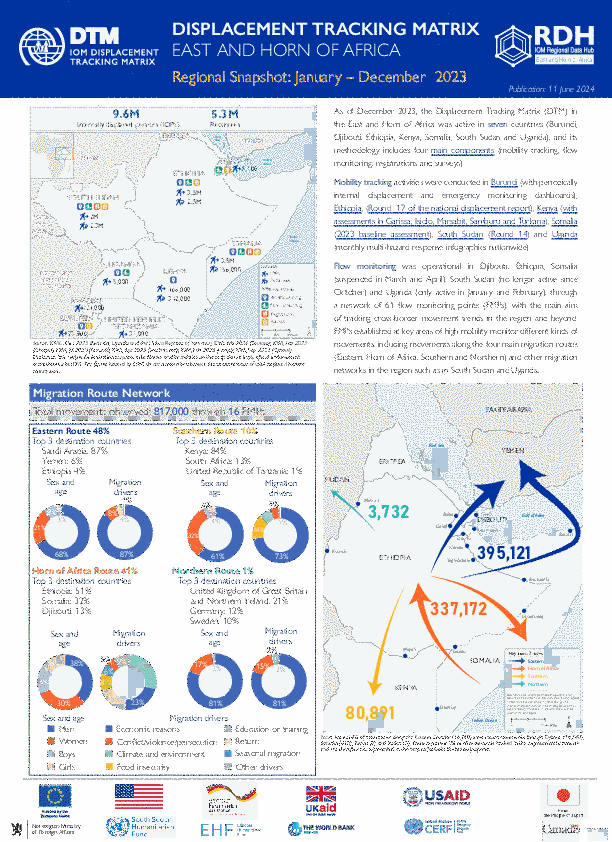-
Countries
-
Data and Analysis
-
Special Focus
-
Crisis Responses
Flow Monitoring
Domain host
migration.iom.int
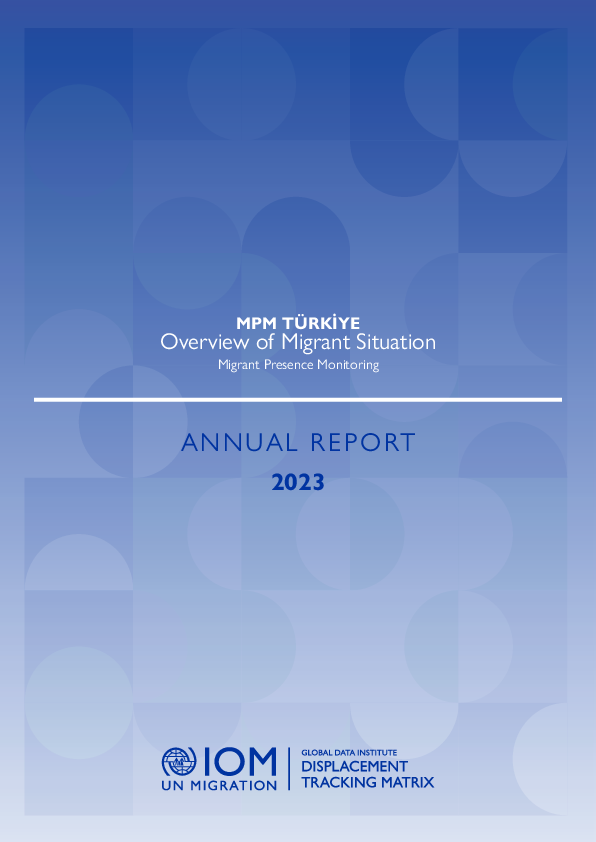
Contact
DTM Türkiye, mpmturkey@iom.int
Language
English
Location
Republic of Türkiye
Period Covered
Jan 01 2023
Dec 31 2023
Activity
- Flow Monitoring
- Migrants presence
According to the latest figures from the Turkish Presidency of Migration Management (PMM), there are more than 4.6 million foreigners in Türkiye, of whom 3.5 million are seeking international protection. Most of them are Syrians (3,214,780 individuals: 3,150,899 urban caseload and 63,881 residing in camps) who have been granted temporary protection status. There is an increase of 16,356 individuals in the number of Syrian nationals staying in camps in comparison to last year's figures.
According to the United Nations High Commissioner for Refugees (UNHCR), there were 296,685 refugees and asylum-seekers in Türkiye as of mid of 2023.
In addition, 1,107,032 foreigners present in Türkiye holding residency permits including short-term residence permit, family residence permit, student residence permit, longterm residence permit, humanitarian residence permit and residence permit for victims of human trafficking.
According to PMM, 254,008 migrants in an irregular situation of different nationalities were apprehended in Türkiye in 2023.4 Please see Page 4 for more details.
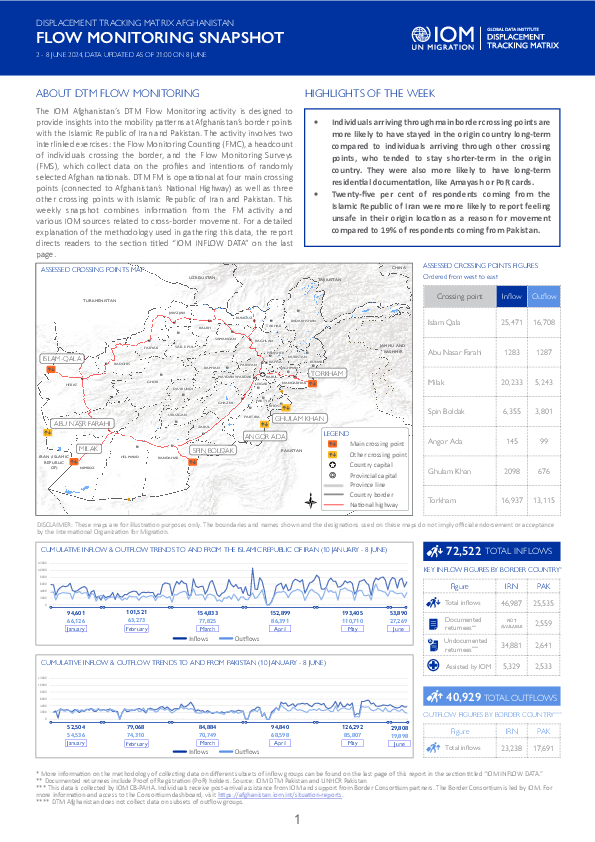
Contact
DTMAfghanistan@iom.int
Language
English
Location
Afghanistan
Period Covered
Jun 02 2024
Jun 08 2024
Activity
- Survey
- Flow Monitoring Survey
- Flow Monitoring
The IOM Afghanistan’s DTM Flow Monitoring activity is designed to provide insights into the mobility patterns at Afghanistan’s border points with the Islamic Republic of Iran and Pakistan. The activity involves two interlinked exercises: the Flow Monitoring Counting (FMC), a headcount of individuals crossing the border, and the Flow Monitoring Surveys (FMS), which collect data on the profiles and intentions of randomly selected Afghan nationals. DTM FM is operational at four main crossing points (connected to Afghanistan’s National Highway) as well as three other crossing points with Islamic Republic of Iran and Pakistan. This weekly snapshot combines information from the FM activity and various IOM sources related to cross-border movement. For a detailed explanation of the methodology used in gathering this data, the report directs readers to the section titled “IOM INFLOW DATA” on the last page.

Contact
DTM Iraq, IraqDTM@iom.int
Language
English
Location
Iraq
Period Covered
Dec 01 2023
Feb 29 2024
Activity
- Survey
- Flow Monitoring Survey
- Flow Monitoring
The Cross-Border Monitoring Report: Protection Risks and Concerns Among Travellers Crossing for Work data on labour-related protection risks among travellers passing through border crossing points monitored by IOM.
The main types of employment for incoming travellers were services, hospitality, and sales (29%); along with factory work (24%); Trained manual worker (15%) and unskilled manual labour (13%). For outgoing travellers, the main types of work were trained manual labour (36%); factory work (18%); Services, hospitality and sales workers (13%) and unskilled manual labour (6%).
The top protection concerns faced by these travellers were the provision of false information by employers regarding the nature of the work and working without receiving the expected payment.
UNHCR and IOM Joint Annual Overview 2023
In 2023, an estimated 212,100 attempts were reported by migrants and refugees to cross the Central Mediterranean Sea from Algeria, Libya, and Tunisia to Europe. This was a 33% increase compared to known departures in 2022.
Of those who attempted to depart in 2023, 71% (151,500) were disembarked in Europe, while 29% (60,600) were rescued or intercepted and disembarked in North Africa (21% in Tunisia, 8% in Libya).
In 2023, more than 3,105 migrants and refugees are known to have lost their lives or gone missing at sea while attempting to cross to Europe along the three Mediterranean routes (eastern, central and western Mediterranean), an increase compared to more than 2,500 deaths recorded in 2022. 61% of the deaths in 2023 took place on the central Mediterranean Sea. According to IOM’s Missing Migrants Project, more than 700 deaths occurred off the coast of Tunisia, more than 680 off Libya and more than 460 off Italian shores. The increasing number and proportion of deaths off the coast of Tunisia is unprecedented in the last 10 years. Notably, more than 1,9008 deaths in the central Mediterranean Sea in 2023 were linked to mass shipwrecks involving the loss of more than 20 lives at sea. However, the real number of dead and missing along these routes is believed to be higher as many incidents go unreported or undetected.
Irregular migration is a complex, dynamic and fragmented phenomenon, and remains difficult to fully picture. Strengthening the understanding of migration routes, trends as well as migrant profiles is critical to protect migrants and support evidence-based policies. The International Organization for Migration's Displacement Tracking Matrix (DTM) and Missing Migrants Project (MMP) collect data on the departures, arrivals, deaths and disappearances of migrants along migratory routes.
This document presents the resumption of migration from the coasts of West Africa to the Canary Islands (Spain). This route, already active in 2006, saw an increasing number of movements in 2023, and in the first months of 2024 there were considerable increases compared to the previous year. The risks, deaths and disappearances following shipwrecks are also on the rise along the Atlantic coasts. Between January and March 2024, 13,115 migrants reached the Canary Islands irregularly after crossing by boat from the coasts of West Africa, an increase of 502 per cent compared to 2023 (2,178 migrants).
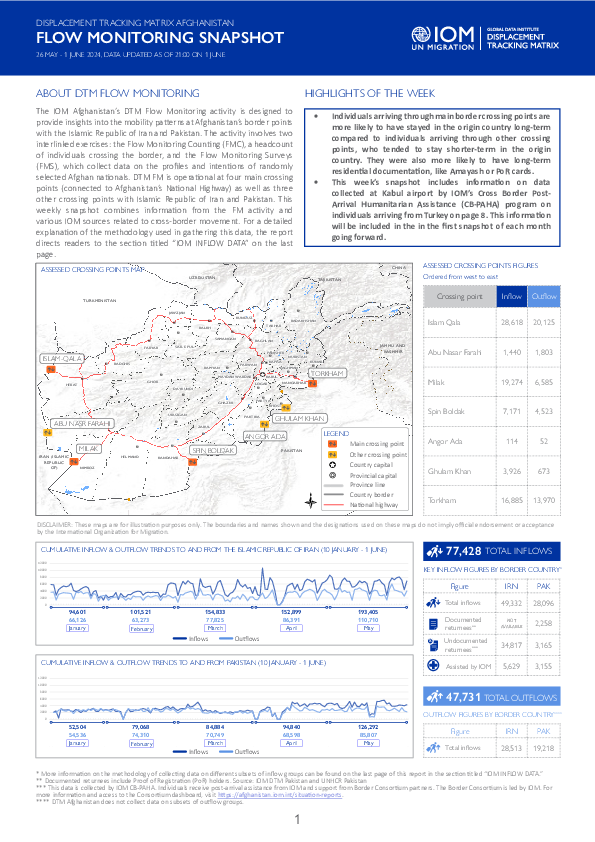
Contact
DTMAfghanistan@iom.int
Language
English
Location
Afghanistan
Period Covered
May 26 2024
Jun 01 2024
Activity
- Survey
- Flow Monitoring Survey
- Flow Monitoring
The IOM Afghanistan’s DTM Flow Monitoring activity is designed to provide insights into the mobility patterns at Afghanistan’s border points with the Islamic Republic of Iran and Pakistan. The activity involves two interlinked exercises: the Flow Monitoring Counting (FMC), a headcount of individuals crossing the border, and the Flow Monitoring Surveys (FMS), which collect data on the profiles and intentions of randomly selected Afghan nationals. DTM FM is operational at four main crossing points (connected to Afghanistan’s National Highway) as well as three other crossing points with Islamic Republic of Iran and Pakistan. This weekly snapshot combines information from the FM activity and various IOM sources related to cross-border movement. For a detailed explanation of the methodology used in gathering this data, the report directs readers to the section titled “IOM INFLOW DATA” on the last page.
As of December 2023, the Displacement Tracking Matrix (DTM) in the East and Horn of Africa was active in seven countries (Burundi, Djibouti, Ethiopia, Kenya, Somalia, South Sudan and Uganda), and its methodology includes four main components (mobility tracking, flow monitoring, registrations and surveys).
Mobility tracking activities were conducted in Burundi (with periodic internal displacement and emergency monitoring dashboards), Ethiopia, (Round 17 of the national displacement report), Kenya (with assessments in Garissa, Isiolo, Marsabit, Samburu and Turkana), Somalia (2023 baseline assessment), South Sudan (Round 14) and Uganda (monthly multi-hazard response infographics nationwide).
Flow monitoring was operational in Djibouti, Ethiopia, Somalia (suspended in March and April), South Sudan (no longer active since
October) and Uganda (only active in January and February), through a network of 61 flow monitoring points (FMPs), with the main aim of tracking cross-border movement trends in the region and beyond. FMPs established at key areas of high mobility monitor different kinds of movements, including movements along the four main migration routes (Eastern, Horn of Africa, Southern and Northern) and other migration networks in the region such as in South Sudan and Uganda.
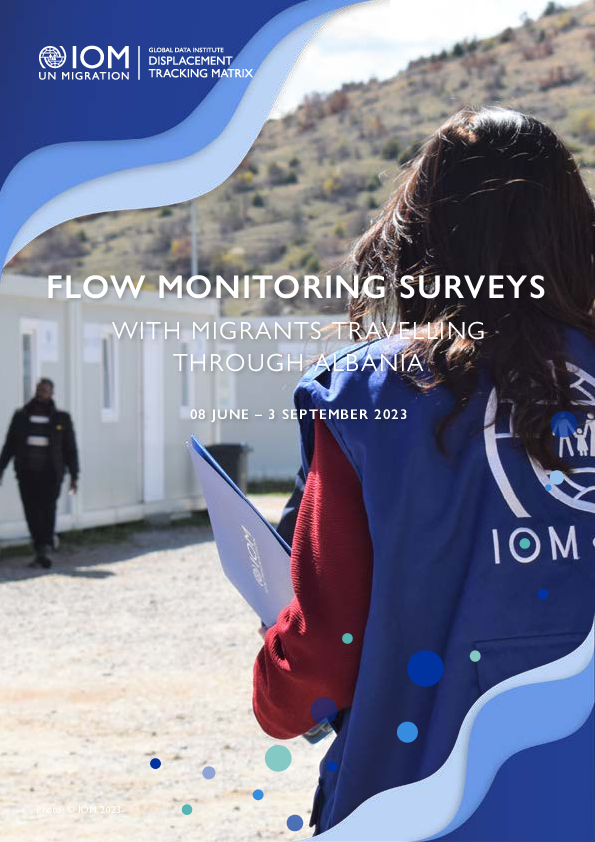
Contact
DTM Europe, DTMMediterranean@iom.int
Language
English
Location
Albania
Period Covered
Jun 08 2023
Sep 03 2023
Activity
- Survey
- Flow Monitoring
This report presents the results of the second round of the Displacement Tracking Matrix (DTM) Flow Monitoring Surveys (FMS) implemented in Albania. The data was collected across Albania from 8 June to 3 September 2023, with a total of 128 individual respondents.
FMS provides a snapshot of the profiles, experiences and needs of migrants transiting through Albania. The survey asks questions on demographics, education and employment backgrounds, the circumstances of the migration journey and migration factors, as well as future intentions.
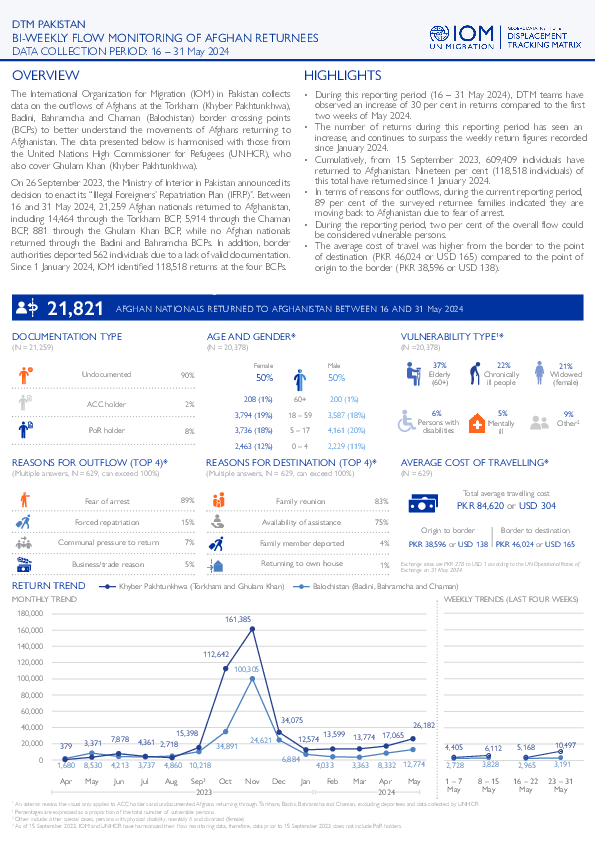
Contact
DTM Pakistan, DTMPakistan@iom.int
Language
English
Location
Pakistan
Period Covered
May 16 2024
May 31 2024
Activity
- Flow Monitoring
The International Organization for Migration (IOM) in Pakistan collects data on the outflows of Afghans at the Torkham (Khyber Pakhtunkhwa), Badini, Bahramcha and Chaman (Balochistan) border crossing points (BCPs) to better understand the movements of Afghans returning to Afghanistan. The data presented below is harmonised with those from the United Nations High Commissioner for Refugees (UNHCR), who also cover Ghulam Khan (Khyber Pakhtunkhwa).
On 26 September 2023, the Ministry of Interior in Pakistan announced its decision to enact its “Illegal Foreigners’ Repatriation Plan (IFRP)”. Between 16 and 31 May 2024, 21,259 Afghan nationals returned to Afghanistan, including 14,464 through the Torkham BCP, 5,914 through the Chaman BCP, 881 through the Ghulam Khan BCP, while no Afghan nationals returned through the Badini and Bahramcha BCPs. In addition, border authorities deported 562 individuals due to a lack of valid documentation. Since 1 January 2024, IOM identified 118,518 returns at the four BCPs.
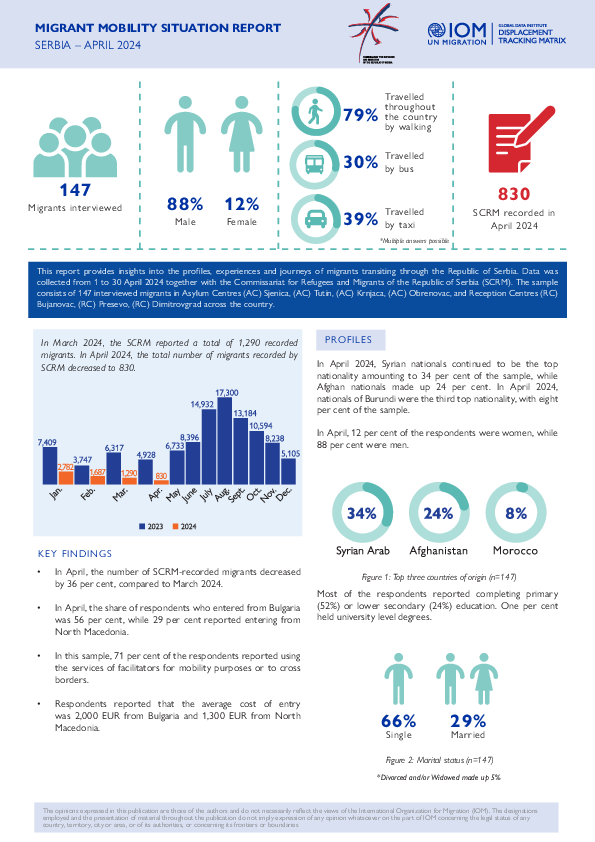
Contact
DTM Europe, DTMMediterranean@iom.int
Language
English
Location
Serbia
Period Covered
Apr 01 2024
Apr 30 2024
Activity
- Survey
- Flow Monitoring
This report provides insights into the profiles, experiences and journeys of migrants transiting through the Republic of Serbia. Data was collected from 1 to 30 April 2024 together with the Commissariat for Refugees and Migrants of the Republic of Serbia (SCRM). The sample consists of 147 interviewed migrants in Asylum Centres (AC) Sjenica, (AC) Tutin, (AC) Krnjaca, (AC) Obrenovac, and Reception Centres (RC) Bujanovac, (RC) Presevo, (RC) Dimitrovgrad across the country.
Pagination
- Previous page
- Page 6
- Next page


